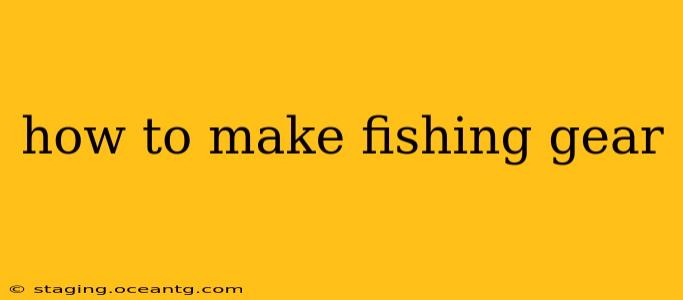For centuries, anglers have crafted their own fishing gear, a tradition blending practicality, resourcefulness, and a deep connection with nature. While modern tackle shops offer an extensive array of pre-made equipment, constructing your own gear offers a unique sense of satisfaction and allows for customization tailored to your specific fishing style and environment. This guide delves into the art of making various fishing gear, from simple hooks to more intricate creations.
What Kind of Fishing Gear Can I Make Myself?
This is a common starting point for many DIY anglers. The possibilities are surprisingly broad, depending on your skill level and available tools. You can make:
- Simple Hooks: Sharpening and shaping basic hooks from wire is a fundamental skill.
- Fishing Rods: Building a rod involves selecting the right materials (bamboo, fiberglass, graphite) and carefully assembling the components.
- Fishing Lines: While commercially produced lines are generally superior, you can experiment with making simple lines from natural fibers like plant materials (although not recommended for serious fishing).
- Lures: Crafting lures is an art form in itself, allowing for endless creativity with materials like wood, metal, feathers, and plastics. Spinners, spoons, and jigs are all within the realm of possibility.
- Floats/Bobbers: Simple bobbers can be carved from cork or balsa wood.
- Fishing Weights: You can melt lead (with proper safety precautions) or use readily available materials like nuts and bolts.
How Do I Make My Own Fishing Hooks?
Making hooks from scratch requires specialized tools and skills, but it’s a rewarding challenge. You’ll need:
- High-carbon steel wire: This is essential for durability and sharpness.
- Wire cutters: To precisely cut the wire.
- Needle-nose pliers: For bending and shaping the wire.
- File or sharpening stone: To hone the point of the hook.
The process involves carefully bending and shaping the wire into the desired hook shape, then sharpening the point. Detailed tutorials on this technique are readily available online, via videos and detailed articles. Remember safety first - always wear appropriate eye protection.
What Materials Do I Need to Make a Fishing Rod?
Creating a fishing rod is a more advanced undertaking, requiring more specialized tools and materials. The components generally include:
- Blank (Rod Shaft): This is the backbone of the rod, typically made from fiberglass, graphite, or bamboo. Fiberglass is a good starting point for beginners due to its affordability and ease of use.
- Guides: These ceramic rings guide the fishing line.
- Reel Seat: Holds the fishing reel.
- Handle: Typically made from cork, EVA foam, or other comfortable materials.
- Epoxy Resin: Used to bind the components together.
Building a fishing rod involves carefully gluing and wrapping the guides, reel seat, and handle onto the blank, ensuring proper alignment and spacing. Again, detailed online resources are available to guide you through this process.
What About Making Fishing Line?
While making fishing line from scratch is less common due to the superior quality and strength of commercial lines, historically, natural fibers like linen or hemp were used. This is more of a historical exploration than a practical approach for modern fishing. The process is labor-intensive and the resulting line would likely be weaker and less durable than modern synthetic lines.
How Can I Make My Own Fishing Lures?
Creating lures is where you can unleash your creativity. Simple lures can be carved from wood and painted, while more complex designs might involve incorporating feathers, metal, or plastic components. Consider these aspects:
- Design: The shape and color of your lure will significantly impact its effectiveness.
- Materials: Wood, plastic, metal, feathers, and even resin can be used.
- Weighting: Properly weighting your lure is crucial for its action in the water.
- Hooks: Attaching sharp and durable hooks is essential for catching fish.
Can I Make Fishing Weights Myself?
Making fishing weights is relatively straightforward. The most common method involves melting lead (always using proper safety precautions including ventilation and protective gear). However, lead is toxic, so consider environmentally friendlier alternatives like using readily available metal objects like nuts and bolts for heavier weights.
In conclusion, making your own fishing gear is a rewarding pursuit, offering a deeper connection with the sport and a chance to create personalized equipment. While some aspects require specialized skills and tools, starting with simpler projects like making bobbers or basic lures can be an excellent entry point into this fascinating world. Remember always to prioritize safety and consult detailed tutorials before starting any project.
